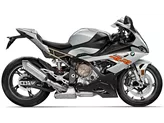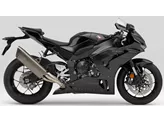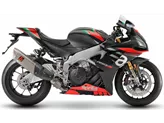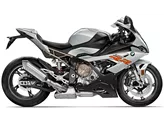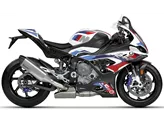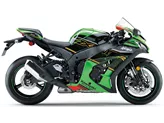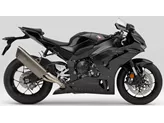BMW S 1000 RR 2017 vs. Suzuki GSX-R 1000 R 2017

BMW S 1000 RR 2017

Suzuki GSX-R 1000 R 2017
Overview - BMW S 1000 RR 2017 vs Suzuki GSX-R 1000 R 2017
The BMW S 1000 RR 2017 and the Suzuki GSX-R 1000 R 2017 are both powerful supersport motorcycles with similar engine specifications. Both bikes have an in-line, 4-cylinder engine with a displacement of 999cc. The BMW S 1000 RR produces 199 HP of power and 113 Nm of torque, while the Suzuki GSX-R 1000 R produces slightly more power at 202 HP and 118 Nm of torque. Both bikes have a high compression ratio of 13 and 13.2 respectively, indicating their high-performance capabilities.
In terms of suspension, both bikes feature upside-down telescopic forks at the front and swing arm suspension at the rear. The chassis of both bikes is made of aluminum, providing a lightweight yet sturdy frame. The BMW S 1000 RR has a twin-tube frame, while the Suzuki GSX-R 1000 R has a twin-tube, twin-spar frame. Both bikes have double disk brakes at the front, but the Suzuki GSX-R 1000 R has the additional feature of monoblock technology in its braking system, enhancing its braking performance.
In terms of dimensions and weights, both bikes have a front tire width of 120 mm and a rear tire width of 190 mm, with a 17-inch diameter for both tires. The wheelbase of the BMW S 1000 RR is slightly longer at 1438 mm compared to the Suzuki GSX-R 1000 R's 1410 mm. The seat height of the BMW S 1000 RR is 815 mm, while the Suzuki GSX-R 1000 R has a slightly higher seat height of 825 mm. The kerb weight of the BMW S 1000 RR with ABS is 208 kg, slightly heavier than the Suzuki GSX-R 1000 R's 203 kg. Both bikes have a fuel tank capacity of 17.5 liters.

BMW S 1000 RR 2017
Now let's compare the strengths and weaknesses of each bike. The BMW S 1000 RR has the advantage of being available with complete electronic equipment, allowing riders to have access to advanced features. The bike also has a strong engine that is powerful and easy to control, making it suitable for both experienced and novice riders. Additionally, the BMW S 1000 RR offers a comfortable seating position, even for taller riders. The bike also boasts a good chassis, providing stability on both the road and track.
On the other hand, the Suzuki GSX-R 1000 R has a high-revving engine with a smooth torque curve, ensuring a thrilling riding experience. The bike is particularly stable on corner exit and radius, making it ideal for riders who enjoy fast-paced riding. The Suzuki GSX-R 1000 R also features a great quickshifter and a high-quality chassis, further enhancing its performance on the track.

Suzuki GSX-R 1000 R 2017
However, the BMW S 1000 RR does have some weaknesses. It may experience brake fade on the racetrack under high load, which can be a disadvantage for riders who frequently engage in high-speed riding. While the ride quality of the BMW S 1000 RR is sufficient for trackdays, it may not be up to par for racing. Additionally, some riders may find the appearance of the BMW S 1000 RR to be dull or outdated, despite its advanced technical features.
Similarly, the Suzuki GSX-R 1000 R also has a few weaknesses. The engine brake of the bike is not adjustable, which may limit the customization options for riders who prefer a specific braking feel. Additionally, the wheely control of the Suzuki GSX-R 1000 R is linked to the traction control system, which may restrict the rider's ability to fine-tune their riding experience.
In conclusion, both the BMW S 1000 RR 2017 and the Suzuki GSX-R 1000 R 2017 are powerful and capable supersport motorcycles. While the BMW S 1000 RR offers a complete electronic package and a comfortable seating position, the Suzuki GSX-R 1000 R excels in high-revving performance and stability on the track. However, both bikes have their weaknesses, such as brake fade for the BMW S 1000 RR and limited adjustability for the engine brake of the Suzuki GSX-R 1000 R. Ultimately, the choice between these two bikes will depend on the rider's preferences and priorities.
Technical Specifications BMW S 1000 RR 2017 compared to Suzuki GSX-R 1000 R 2017
Pros and Cons in comparison
Pros and Cons in comparison
BMW S 1000 RR 2017

The well-balanced universal talent will also be at the forefront of many comparison tests in 2017. It still scores with the outstanding engine and the universal and complete equipment.
Suzuki GSX-R 1000 R 2017

Suzuki has done a great job with the GSX-R 1000 R 2017. A powerful motorbike with a fabulously smooth torque curve. Actually unbelievable at 202 hp! The chassis is of high quality and the electronics package has no tinsel but delivers top performance.
Price Comparison Avarage Market Price BMW S 1000 RR vs Suzuki GSX-R 1000 R
There are a few key differences between a BMW S 1000 RR 2017 and a Suzuki GSX-R 1000 R 2017. There are the same number of bikes of both models available on the 1000PS.de marketplace, specifically 9. It takes less time to sell a BMW S 1000 RR with 96 days compared to 176 days for a Suzuki GSX-R 1000 R. Since model year 2010 1000PS.de editors have written 135 reviews for the BMW S 1000 RR and 13 reviews for the Suzuki GSX-R 1000 R since model year 2017. The first review for the BMW S 1000 RR was published on 4/16/2008 and now has more than 4,000 views. This compares to more than 197,700 views for the first review on Suzuki GSX-R 1000 R published on 10/4/2016.



